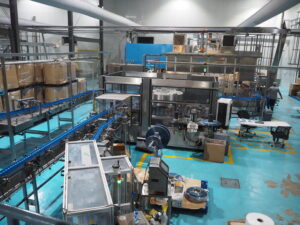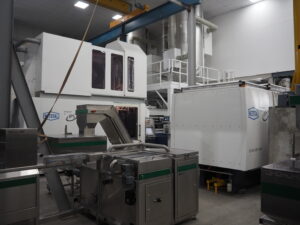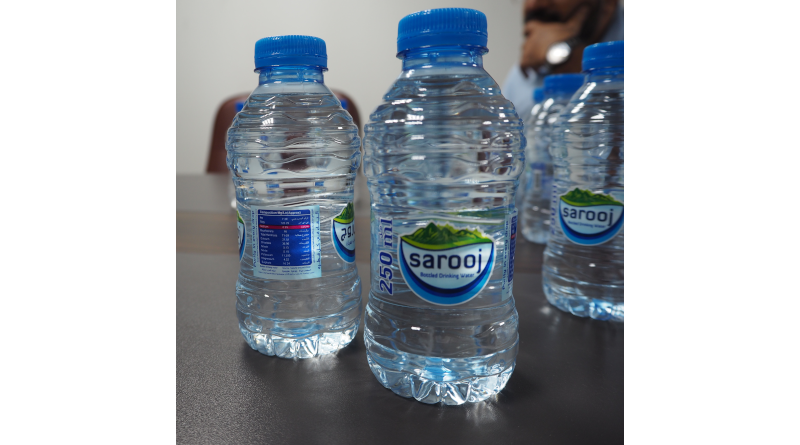From 0 to 4 million bottles per day in 2 years
Visit to Sarooj Water in Oman, by Alexander Büchler

In Oman, just three years ago, a 24-pack of the favourite 250 ml single-serve water bottle cost 1.60 euros in a discount supermarket. That’s not even 7 eurocents per bottle. Supermarkets are now offering the same 24-pack of 250 ml Sarooj water for 0.80 euro – just half the price, or just 3.5 eurocents per bottle. What is behind it? We asked the driving force behind Sarooj Water, Mr Fahad Mohammed Riaz.
Four years ago, Fahad’s world consisted primarily of trading in wood for house and furniture construction. In search of another site for his logistics operations, he was offered a site in Muladdah, near Muscat. At first he wasn’t convinced, but when he heard that it included a deep well licence for the best underground water in Oman, his ears perked up. The water is virtually sodium-free and has a tangy but balanced flavour. The two quickly came to an agreement and Fahad and his team set about developing a concept for the water from the well.
What can I do better than the competition? How can I produce and sell the right quantities? A concept was quickly developed: it had to be the best bottled water in Oman, and the end consumer should only pay half as much as before. The supermarkets are supplied by full lorry loads only. The retail trade and Farad as a producer did without the usual margins and still made their money from ordinary consumers. He is enthusiastic about the concept of Niagara Water in the USA. A joint meeting with the owner family Peykoff sealed his decision: concentrate on one product, a light bottle and in bulk.

What was missing was a suitable bottle and the associated production facilities. Two years ago, the moment came. After a lot of research, Fahad decided on a bottle with the relatively large 29/25 cap that is common in the region. With the Neck-Lite from Redupet, it was possible to make the bottle 8% lighter at 6.85 g. After initial scepticism, blow moulding trials at Krones and Sipa showed that the bottle could be produced. Corvaglia developed a shutter weighing just 1.1 g.
Neither is available on the open converter market, so Fahad ordered the corresponding preform and cap systems from Netstal. A key factor in the success of the lightweight bottle was that Otto Hofstetter managed to build a 128-cavity mould for the Neck-Lite preform for the first time. Until now, the Neck-Lite had only been produced on small preform tools. The material advantage quickly pays for itself compared to the additional expense of in-house preform and cap production. Needless to say, Fahad also produces the film for the 24-pack himself and prints and cuts his own labels.

The 128-cavity mould from Otto Hofstetter went into the Top Entry 400 t Netstal lines, the 48-cavity cap mould from Corvaglia into the 300 t Netstal. It is important for Fahad to have production in-house, so he has a direct influence on the quality of the preforms and the caps. A simple example is the 100% in-line inspection of the caps by an IMD inspection system. After the inspection, he fills the caps into boxes that are actually intended for 5,000 to 6,000 caps. However, it only fills 4,000 caps so that the caps arrive at the capper virtually damage-free. The reject rate is in the sub-promille range.
It all began with a small Krones plant in the original building. It quickly became clear that the concept was popular, and so Fahad ordered two new lines: a Sipa line and another Krones line, both in the 50,000 bph range.
The Sipa system consists of an Xtra-20 cavity rotary blow-moulding machine in a Sincro Bloc with a Sipa Flextronic 70-20 filler. This is followed by a labeller, a Dimac shrink wrapper and a Sipa PTF2 palletiser. The Krones is a blocked system with labelling between the stretch blow-moulding machine and the filler.

Interestingly, both produce the same bottle and also use the same label and cap. The stretch blow moulds for the same bottle were produced by Sipa and Krones for their own lines. In the end, the quality of the filled bottle is indistinguishable whether it comes from the Sipa or Krones plant. In addition to the Krones plant, the same plant with 50,000 bottles is to be built, and the drying line has already been designed for this. The systems run 24 hours a day, 7 days a week, interrupted only by scheduled maintenance. Fahad could sell more if he produced more. He also has Dubai in mind as another market, just five hours away by lorry.

